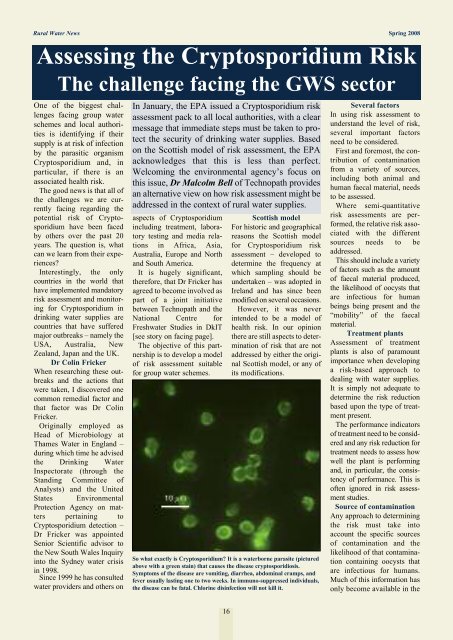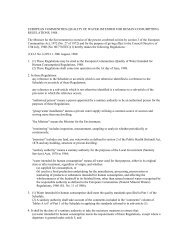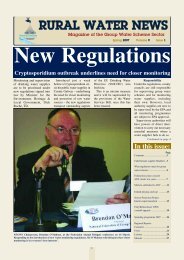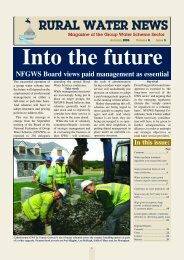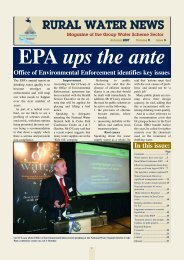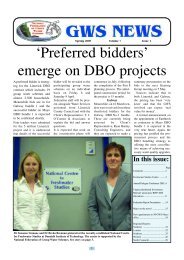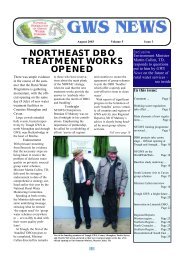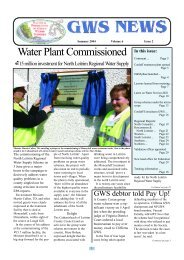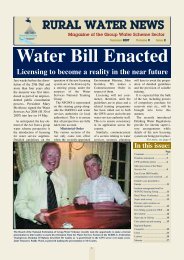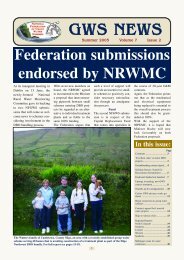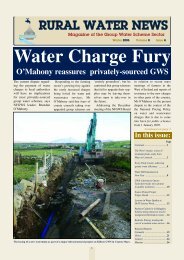Inaction ‘not an option’
Spring 2008 - nfgws
Spring 2008 - nfgws
- No tags were found...
You also want an ePaper? Increase the reach of your titles
YUMPU automatically turns print PDFs into web optimized ePapers that Google loves.
Rural Water News Spring 2008<br />
Assessing the Cryptosporidium Risk<br />
The challenge facing the GWS sector<br />
One of the biggest challenges<br />
facing group water<br />
schemes <strong>an</strong>d local authorities<br />
is identifying if their<br />
supply is at risk of infection<br />
by the parasitic org<strong>an</strong>ism<br />
Cryptosporidium <strong>an</strong>d, in<br />
particular, if there is <strong>an</strong><br />
associated health risk.<br />
The good news is that all of<br />
the challenges we are currently<br />
facing regarding the<br />
potential risk of Cryptosporidium<br />
have been faced<br />
by others over the past 20<br />
years. The question is, what<br />
c<strong>an</strong> we learn from their experiences?<br />
Interestingly, the only<br />
countries in the world that<br />
have implemented m<strong>an</strong>datory<br />
risk assessment <strong>an</strong>d monitoring<br />
for Cryptosporidium in<br />
drinking water supplies are<br />
countries that have suffered<br />
major outbreaks – namely the<br />
USA, Australia, New<br />
Zeal<strong>an</strong>d, Jap<strong>an</strong> <strong>an</strong>d the UK.<br />
Dr Colin Fricker<br />
When researching these outbreaks<br />
<strong>an</strong>d the actions that<br />
were taken, I discovered one<br />
common remedial factor <strong>an</strong>d<br />
that factor was Dr Colin<br />
Fricker.<br />
Originally employed as<br />
Head of Microbiology at<br />
Thames Water in Engl<strong>an</strong>d –<br />
during which time he advised<br />
the Drinking Water<br />
Inspectorate (through the<br />
St<strong>an</strong>ding Committee of<br />
Analysts) <strong>an</strong>d the United<br />
States Environmental<br />
Protection Agency on matters<br />
pertaining to<br />
Cryptosporidium detection –<br />
Dr Fricker was appointed<br />
Senior Scientific advisor to<br />
the New South Wales Inquiry<br />
into the Sydney water crisis<br />
in 1998.<br />
Since 1999 he has consulted<br />
water providers <strong>an</strong>d others on<br />
In J<strong>an</strong>uary, the EPA issued a Cryptosporidium risk<br />
assessment pack to all local authorities, with a clear<br />
message that immediate steps must be taken to protect<br />
the security of drinking water supplies. Based<br />
on the Scottish model of risk assessment, the EPA<br />
acknowledges that this is less th<strong>an</strong> perfect.<br />
Welcoming the environmental agency’s focus on<br />
this issue, Dr Malcolm Bell of Technopath provides<br />
<strong>an</strong> alternative view on how risk assessment might be<br />
addressed in the context of rural water supplies.<br />
aspects of Cryptosporidium<br />
including treatment, laboratory<br />
testing <strong>an</strong>d media relations<br />
in Africa, Asia,<br />
Australia, Europe <strong>an</strong>d North<br />
<strong>an</strong>d South America.<br />
It is hugely signific<strong>an</strong>t,<br />
therefore, that Dr Fricker has<br />
agreed to become involved as<br />
part of a joint initiative<br />
between Technopath <strong>an</strong>d the<br />
National Centre for<br />
Freshwater Studies in DkIT<br />
[see story on facing page].<br />
The objective of this partnership<br />
is to develop a model<br />
of risk assessment suitable<br />
for group water schemes.<br />
Scottish model<br />
For historic <strong>an</strong>d geographical<br />
reasons the Scottish model<br />
for Cryptosporidium risk<br />
assessment – developed to<br />
determine the frequency at<br />
which sampling should be<br />
undertaken – was adopted in<br />
Irel<strong>an</strong>d <strong>an</strong>d has since been<br />
modified on several occasions.<br />
However, it was never<br />
intended to be a model of<br />
health risk. In our opinion<br />
there are still aspects to determination<br />
of risk that are not<br />
addressed by either the original<br />
Scottish model, or <strong>an</strong>y of<br />
its modifications.<br />
So what exactly is Cryptosporidium? It is a waterborne parasite (pictured<br />
above with a green stain) that causes the disease cryptosporidiosis.<br />
Symptoms of the disease are vomiting, diarrhea, abdominal cramps, <strong>an</strong>d<br />
fever usually lasting one to two weeks. In immuno-suppressed individuals,<br />
the disease c<strong>an</strong> be fatal. Chlorine disinfection will not kill it.<br />
Several factors<br />
In using risk assessment to<br />
underst<strong>an</strong>d the level of risk,<br />
several import<strong>an</strong>t factors<br />
need to be considered.<br />
First <strong>an</strong>d foremost, the contribution<br />
of contamination<br />
from a variety of sources,<br />
including both <strong>an</strong>imal <strong>an</strong>d<br />
hum<strong>an</strong> faecal material, needs<br />
to be assessed.<br />
Where semi-qu<strong>an</strong>titative<br />
risk assessments are performed,<br />
the relative risk associated<br />
with the different<br />
sources needs to be<br />
addressed.<br />
This should include a variety<br />
of factors such as the amount<br />
of faecal material produced,<br />
the likelihood of oocysts that<br />
are infectious for hum<strong>an</strong><br />
beings being present <strong>an</strong>d the<br />
“mobility” of the faecal<br />
material.<br />
Treatment pl<strong>an</strong>ts<br />
Assessment of treatment<br />
pl<strong>an</strong>ts is also of paramount<br />
import<strong>an</strong>ce when developing<br />
a risk-based approach to<br />
dealing with water supplies.<br />
It is simply not adequate to<br />
determine the risk reduction<br />
based upon the type of treatment<br />
present.<br />
The perform<strong>an</strong>ce indicators<br />
of treatment need to be considered<br />
<strong>an</strong>d <strong>an</strong>y risk reduction for<br />
treatment needs to assess how<br />
well the pl<strong>an</strong>t is performing<br />
<strong>an</strong>d, in particular, the consistency<br />
of perform<strong>an</strong>ce. This is<br />
often ignored in risk assessment<br />
studies.<br />
Source of contamination<br />
Any approach to determining<br />
the risk must take into<br />
account the specific sources<br />
of contamination <strong>an</strong>d the<br />
likelihood of that contamination<br />
containing oocysts that<br />
are infectious for hum<strong>an</strong>s.<br />
Much of this information has<br />
only become available in the<br />
16


